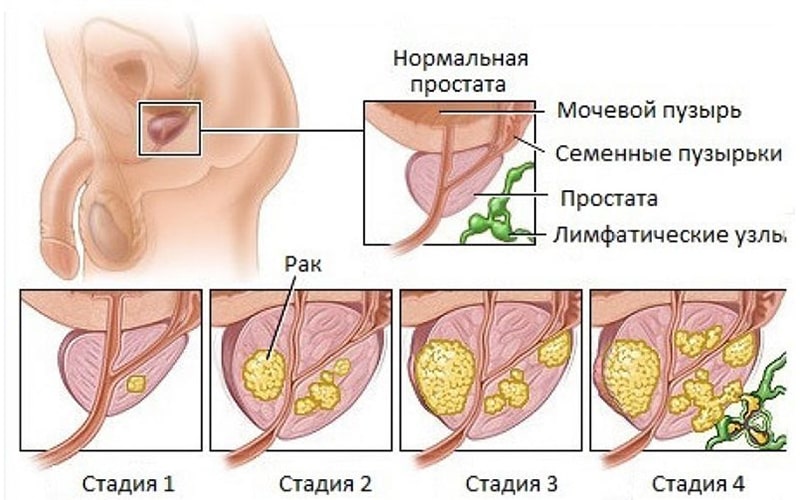ADDRESS:
Degtyarevskaya st., 48
Kyiv
RECEPTION OF PATIENTS:
Mon-Fri 8:00-18:00
Sat 9:00-18:00
[ivory-search id="15340" ]
Address
Kyiv,
Degtyarevskaya st., 48
Opening hours
Mon-Fri 8:00-18:00
Sat 9:00-18:00
Sun – day off
ADDRESS:
Degtyarevskaya st., 48
Kyiv
RECEPTION OF PATIENTS:
Mon-Fri 8:00-18:00
Sat 9:00-18:00
Address
Kyiv,
Degtyarevskaya st., 48
Opening hours
Mon-Fri 8:00-18:00
Sat 9:00-18:00
Sun – day off
Home » Prostate cancer – specifics and treatment of the disease
The prostate or prostate gland is an important part of the male reproductive system. Its key functions include the production of secretions released during ejaculation to liquefy sperm and maintain sperm viability, and the ability to retain urine during erection.
Prostate cancer is one of the leading cancer diseases in men (25% of all tumors in men). As a rule, the pathology manifests itself in patients over the age of 60 years and may be caused by disorders of endocrine regulation in the sexual sphere.

The key feature of prostate cancer is the slow development of the malignancy with the absence of obvious symptoms in the early stages of the disease. That is why experts recommend that men over 45 years of age undergo regular preventive examinations for timely detection of pathology.
Regardless of the specific region in which the patient lives, prostate cancer manifests itself for the same number of reasons:
As mentioned above, in the early stages the disease rarely manifests itself. Often the following symptoms are characteristic of prostate cancer: frequent urge to urinate with a feeling of incomplete emptying of the bladder, spastic pain in the groin, the appearance of a thin or intermittent stream of urine, the need to strain the abdominal muscles to empty the bladder. But the problem is that these same signs may indicate the presence of other diseases – prostatitis (inflammation of the prostate gland) or benign tumors (prostate adenoma).
If, in the presence of these symptoms, prostatitis is not detected, it may indeed be a tumor. Deterioration of erection may occur due to tumor growth and compression of the nerves that affect erection. The volume of ejaculated sperm may also decrease due to blockage of the vas deferens by the tumor.
More severe symptoms – hematuria (blood in the urine), pain in different parts of the body (in the legs, back – in the presence of metastases) appear already in the later stages, when the disease requires very complex, unpleasant and lengthy treatment. Therefore, it is extremely important to periodically undergo a preventive examination with a urologist and contact if you have the slightest alarming symptoms.
Considered a key treatment for prostate cancer. Among the most common surgical interventions is radical prostatectomy (removal of the organ along with the seminal vesicles).
The table shows some data on prostate cancer surgery at the AVICENNA MED clinic:
| Specialization | Oncourology |
| Method | Open or Laparoscopic |
| Anesthesia | General anesthesia |
| Operation duration | 120-180 minutes |
| Stay at the clinic | 3-5 days |
| Advantages |
|
| Estimated cost of the case | Determined after consultation with an oncourologist |
External beam radiation therapy is a radical method of treating prostate cancer, where radiation exposure to the prostate and nearby lymph nodes using focused radioactive radiation from a special device is used as a tool. Brachytherapy is the interstitial effect of radioactive radiation using grains with a radioactive drug, brought directly to the prostate tumor.
Such methods give good results, but are inferior to the surgical method, since they do not allow histological analysis of the extent of the tumor, which directly affects the specifics of treatment.
The use of hormonal therapy is highly effective when used in the later stages of cancer – it blocks the effect of testosterone on the prostate or suppresses the production of the hormone.
The decision to treat the tumor or monitor its development is discussed directly with the patient. This is a trade-off between the expected effects of different treatments in terms of prostate cancer survival and maintenance of a comfortable life. The prognosis of the disease depends on the stage of the process. The earlier treatment is started, the higher the likelihood of a favorable outcome. In the early stages, with adequate treatment, the prognosis is conditionally favorable, and the ability to work is completely restored. In the later stages, the prognosis is certainly unfavorable, and the disease is fatal.
In terms of factors that a person can influence, prostate cancer prevention includes two main areas – a healthy lifestyle and proper nutrition.
A healthy lifestyle, first of all, means giving up bad habits and maintaining optimal physical shape and sexual behavior, taking into account the age category. As for the diet, it is important to place special emphasis on the consumption of vegetables and fruits (especially cabbage, soy, tomatoes, grapes, etc.) and reduce the consumption of fatty animal foods, as well as foods with a high calcium content (for example, milk).
The use of content and photo materials of the site without the consent of the copyright holder is not allowed!
License – order of the Ministry of Health of Ukraine dated June 1, 2017. No. 592
License for Dentistry – order of the Ministry of Health of Ukraine dated December 15, 2022 No. 2270
© 2025 | AVICENNA MED – center for Pronovative Medicine. Kyiv, Ukraine
License – order of the Ministry of Health of Ukraine dated June 1, 2017. No. 592
License for Dentistry – order of the Ministry of Health of Ukraine dated December 15, 2022 No. 2270
The use of content and photo materials of the site without the consent of the copyright holder is not allowed!
© 2025 | AVICENNA MED – center for Pronovative Medicine. Kyiv, Ukraine

Please fill out the form below and we will call you back within 30 minutes, or give us a call at one of our phone numbers.
Mon-Fri 8:00-18:00
Sat 9:00-18:00
Sun – day off
The use of content and photo materials of the site without the consent of the copyright holder is not allowed!
© 2017-2025 | “AVICENNA MED – center for Pronovative Medicine. Kyiv, Ukraine
License – order of the Ministry of Health of Ukraine dated June 1, 2017. No. 592